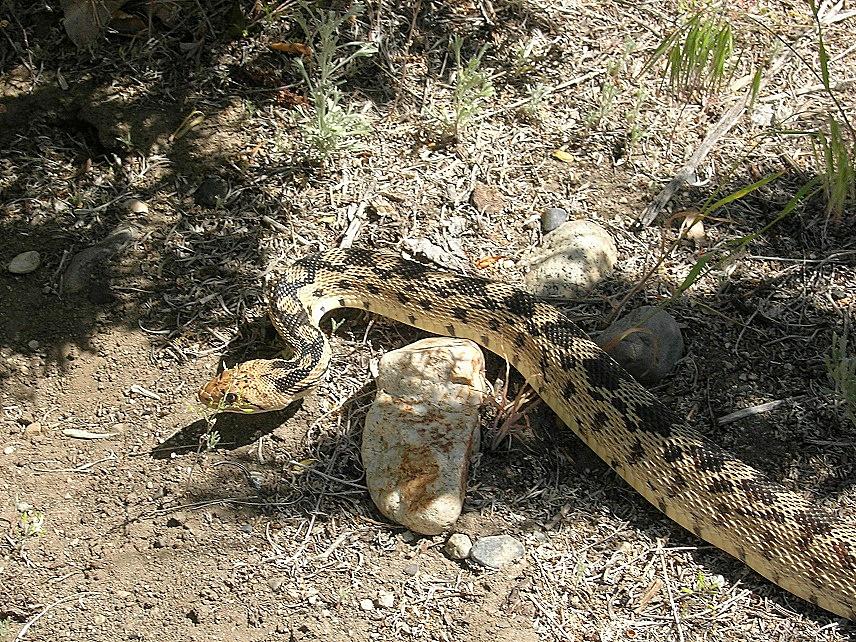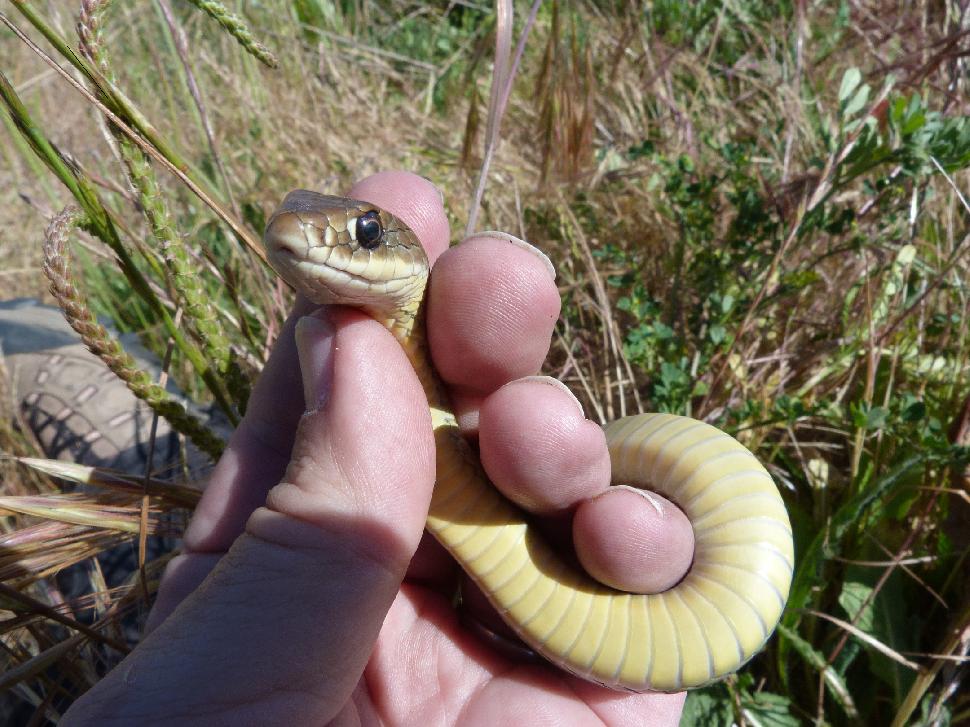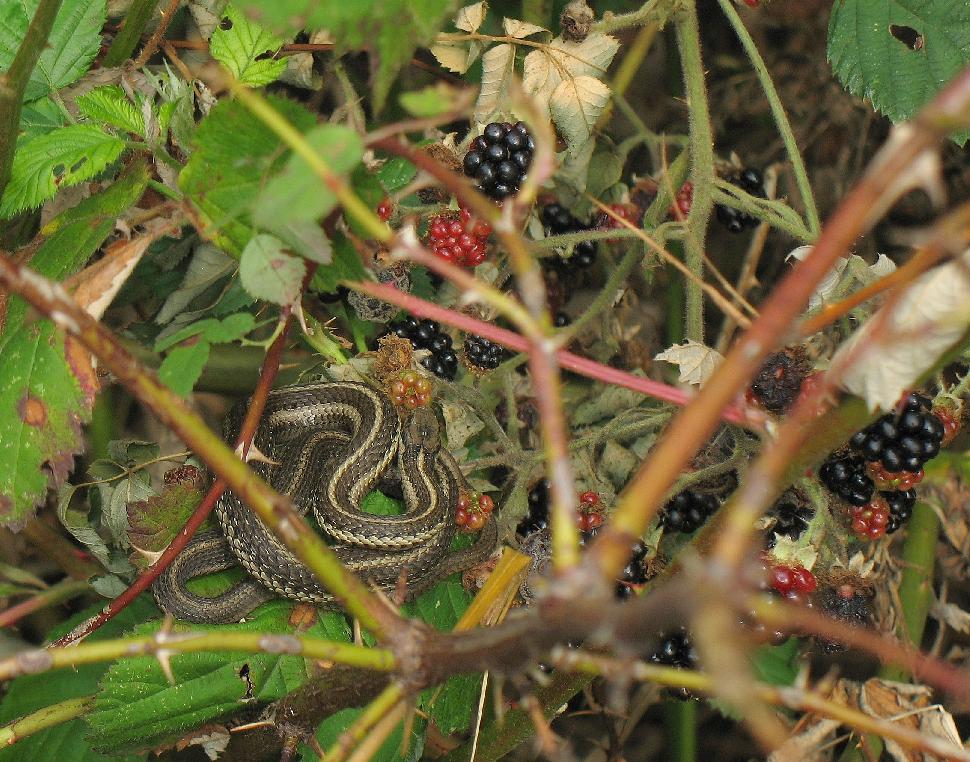Snakes inhabit every continent of the world except Antarctica and can range in size from the miniature thread snake (10-cm long) to the 9-metre reticulated python. Some inject venom through hollow fangs while others use patience and strength to squeeze their dinner to death. The reptiles inhabit a variety of environments including trees, deserts, mountains, swamps and backyards.
Sadly (or happily, depending on your ophiophobia), B.C. is home to only nine species of snakes but they do included those that lay eggs, one venomous species, a tiny snake and a true boa constrictor. Whether you’re in the garden or hiking this spring, you may just spy one quickly cross your path.
Northern Pacific Rattlesnake
Latin Name: Crotalus oreganus oreganus
This is the one snake everyone hopes to spot – from a distance. It does have a distinctive appearance and broad, triangular head, but chances are your eyes won’t get any farther than that rattling tail; that sound alerting you that you are about to make a huge mistake. This is the only venomous snake that inhabits B.C., specifically in the Thompson-Okanagan region. If you’re hiking in the region consider doing so with a tall walking stick.
Rattlers are not aggressive, preferring a good hiding place or a fast exit to confronting something as alarming as a giant hiker. If your presence has evoked a rattle, stop. Give the snake a minute or two to calm down and then slowly back away. Don’t try to capture or kill the rattler; not only are they protected, they also do a great job of keeping the rodent population manageable. Their diets involve chowing down on mice, rats, voles and the occasional squirrel.
Pregnant females give birth in the spring and the tiny little snakes are just as venomous as their parents but lack a functional rattle.
Great Basin Gopher Snake

Latin Name: Pituophis catenifer deserticola
A gorgeous snake with dark ‘squarish’ blotches running down the back of a creamy yellow body, the species prefers the hot, dry interior of the province. Growing to a maximum length of 2.4-metres, it’s also the largest snake in the province. Although non-venomous the gopher snake is similar in colour to the rattlesnake and has adopted the rattlers’ threatening swaying motion when confronted. Add some crunchy dry leaves that a nervous hiker can mistake as a rattle, and many a gentle gopher snake has provided the uninformed backpacker with a harrowing story of escaping near death.
Gopher snakes subdue their prey by constriction, squeezing their dinner until the victim’s heart stops and it can be easily swallowed. They are avid hunters and can be one of the best pest control methods for farmers that provide the three critical elements: hibernacula (dens), egg-laying sites and food in the summer. Dens provide protection from freezing and eggs are preferentially laid in south-facing sites with sand or small rocks to nest in.
Eggs hatch in August or September but the hatchlings almost immediately seek a place to hibernate (hibernacula) and emerge in the spring when the rodents are plentiful.
Night Snake
Latin Name: Hypsiglena torquata deserticola
Cryptic and nocturnal, the night snake is poorly understood but bears a slight resemblance to the rattlesnake. Although they are venomous, the venom is quite weak and harmful only to the small prey they hunt. They hibernate over the winter possibly sharing the dens with rattlesnakes giving them easy access to a favorite snack: baby rattlers. When not nibbling on den-mates the night snake prefers to ambush amphibians and reptiles. The snakes bury themselves in sandy soil using their upturned eyes to peer out of the sandy trap. Passing prey are quickly snagged as the night snake springs out of the trap. Grooved teeth in the back of the mouth injects a small amount of venom into the amphibian to subdue it.
One of the rarest snakes in the country, the night snake habitat is limited to south-central B.C., mainly the Okanagan Valley. The rarity of the species and encroaching human urbanization has put the night snake on the provincial red list, marking it at-risk. Because of this, the Ministry of the Environment requests any sightings of the elusive night snake be reported to provide further knowledge of their activities.
Rubber Boa
Latin Name: Charina bottae
Looking much like a shiny, rubber snake, the boa is brown to olive green with an orange-yellow belly. With no neck and tiny eyes, it can also be difficult to distinguish which end of the snake contains the teeth. It’s a feature the snake uses to its advantage by waving the tail about in a manner similar to a striking snake. Despite the threatening, jabbing show, the boa is not built for speed. It prefers to lounge about under logs, waiting for prey to stumble across its path. The snakes will also enter rodent dens to consume babies, using their tails to keep the mother mouse from entering the nest. The slow-moving boa can be found climbing trees to find tasty eggs and nestlings, and swimming to catch water-loving prey.
Long-living and adaptable, rubber boas range from the southern regions of the province to as far north as Williams Lake. They prefer mountainous, wooded areas that include some grasslands, rivers and a variety of tree species.
Rubber boas produce a few young in mid-August but only reproduce every four years. They are at risk from both a low reproduction rate and the tendency of humans to capture the slow, mild-mannered snakes (which tend to do poorly in captivity).
Western Yellow-bellied Racer

Latin Name: Coluber constrictor mormon
Long and slender, the racer is similar in colour to the rubber boa but can reach lengths of up to two metres. Unlike the boa, the racer is highly active and aggressive when threatened. The speedy snakes are daytime hunters both on the ground and in the trees. Despite having the species name of “constrictor”, the racer doesn’t squeeze its prey. Instead, it tends to swallow it alive as quickly as possible or with minimal biting. Adults will eat rodents, reptiles, frogs, and even birds. But what they really love are insects like crickets and grasshoppers, and baby racers are mainly insectivores.
The snakes inhabit grasslands, open forests, marshes and farmland in B.C.’s hot, dry interior.
Generally you’ll find them in Similkameen, Fraser, Okanagan and Thompson watersheds. Little is known about the population but they are considered at risk from human population and the Ministry of the Environment requests information if you see any of the racers.
Sharp-tailed Snake
Latin Name: Contia tenuis
Only around 30-cm long, the tiny snake is not much wider than a pencil and only come out at night. As the name implies, the tail ends in a pointed scale and the body is generally red/yellow/gray with a stripe along each side. Their defensive activities consist of curling into a ball and jabbing the sharp tail spine into the predator, hoping to startle the threat into inactivity long enough to escape.
The small snakes are small enough to be prey and provide a quick meal for birds, raccoons, mink, shrews and garter snakes. Their own preferred meal is slug and they have specialized teeth that help them swallow the slimy snack. They live in habitats that support their diet, spending most of their time in moist woodlands near streams.
The red listed snakes are endangered but so little is known about them that it’s unclear why. Take note if you spot one and if you’ve ever slipped while hiking and put a finger through a slug you’ll want to protect this very beneficial species.
Garter Snakes (3) – Common, Northwestern, Western Terrestrial

Latin Names:
Common – Thamnophis sirtalis (pickering, fitchi, parietalis)
Northwestern – Thamnophis ordinoides
Western Terrestrial (Wandering) – Thamnophis elegans vagrans
There are three subspecies of the common garter snake in the province : Puget Sound (found on Vancouver Island and the Lower Mainland), Valley (southern B.C. and the northern coast) and Red-sided (eastern edge near the prairie provinces). They range in size from 45-cm to 1.3-metres. All three are black/green with a greenish-yellow stripe down the back and occasionally red side stripes or blotches. They eat small amphibians, insects, earthworms and once in awhile a small mammal or bird. If captured the snakes will release a smelly substance to deter its predator and resort to biting if the smell isn’t successful.
The Northwestern species varies in colour and may be black, brown or olive with a stripe down the back along the side or missing entirely. The snakes are small, only 30 to 50-cm in length. Their size means they are as often prey as predator and they consume mainly small creatures such slugs and worms, although the larger ones will eat an egg if they can get it in their mouth.
Northwestern garters are found in the southwest areas of the province, along the coastal islands and on Vancouver Island. They prefer damp, vegetated areas and are often in weedy patches along roads and around homesteads where items left outside provide shelter.
The most common visitor to backyards, the Western Terrestrial, also called Wandering, is mostly grey with lighter stripes on its back and sides. Like the other varieties of garter, the Western Terrestrial uses a discharge of feces and musk to convince a predator that it smells too bad to hang onto. These guys will eat just about anything including slugs, mammals and fish and have the most varied diet of any of the provincial snakes. They also have a trick not found in the other garter snakes: a mild toxin in their saliva that helps subdue larger rodents.

